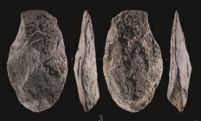Hand-ax relics hailed as breakthrough
By WANG KAIHAO | China Daily | Updated: 2021-09-28 07:00

Groundbreaking archaeological finds of stone tools on the Qinghai-Tibetan Plateau offer crucial clues to how early-stage modern humans migrated across Eurasia more than 100,000 years ago.
More than 6,000 stone and earthen artifacts have been discovered at the Piluo site in Daocheng county, Sichuan province, the National Cultural Heritage Administration said at a news conference on Monday. Piluo is the largest known, best preserved archaeological site from the Paleolithic period-dating from roughly 2.5 million years ago to around 10,000 years ago-on the plateau.
Highlights of the discoveries include Acheulean hand axes, which have been found mainly in prehistoric sites across Africa and the western coast of Eurasian continent. This type of relic, first found in France, is generally considered by scholars to represent the highest level of tool manufacturing at the time.
The Piluo site was found in May 2020, and archaeological excavation formally began in April. Newly unearthed artifacts thus became the world's highest-altitude finding-at 3,750 meters above sea level-of Acheulean tools, the designation for a Lower Paleolithic culture's skillfully made flint axes.
Tuesday marked the first anniversary of General Secretary Xi Jinping's delivery of the keynote speech at the 23rd group study session of the Political Bureau of the Communist Party of China Central Committee. He emphasized the significance of archaeological studies to better explore unknown parts of Chinese history and reveal the origins of the country's various cultures.
Following the guidance, Chinese archaeologists endeavored to touch on less-explored areas in the past year to make breakthroughs through interdisciplinary research, said Chen Xingcan, head of the Chinese Academy of Social Sciences' Institute of Archaeology, who had offered suggestions on last year's group study.
Chen said at Monday's news conference that the discovery of the Piluo site is "world class" and an outstanding example of the recent breakthroughs, because it offers precious and solid evidence of Acheulean tools among Chinese archaeological artifacts.
Previously, such tools were only occasionally found in China and were usually thought to be rougher than their counterparts found farther west.
"It's still a new finding, and we've just touched the tip of an iceberg," Chen said. "We have no idea how many discoveries will be made within such a huge site."
Archaeological investigation indicates that the Piluo site covers more than 1 square kilometer, including 60 heritage spots, but only 200 square meters have been excavated so far.
Hand axes from the site's upper layer are believed to have been made at least 130,000 years ago, and the process of dating the ones found in lower layers is still ongoing, according to Zheng Zhexuan, an archaeologist with the Sichuan Provincial Cultural Relics and Archaeology Research Institute.
"They're so far the most exquisite and most complete Acheulean tools in East Asia," Zheng said. The findings "also filled a gap of academic research to indicate how human beings migrated and thus brought cultural communication during that ancient time".
Seven consecutive layers of earth that were minimally disturbed by natural erosion provided the first sequence for studying the culture of the Paleolithic period in Southwest China and also set a chronological benchmark for other sites, Zheng added.
He also said that finding the hand axes on the Qinghai-Tibetan Plateau offers crucial clues for the study of early humans' ability to conquer the harsh natural environment and the beginning of human settlements on the plateau.
Gao Xing, a researcher with the Institute of Vertebrate Paleontology and Paleoanthropology, said that such axes, which are symmetrical and made not only for functionality, are "the first tool in human history with a designed shape".
"They reflect early humans' aesthetics, wisdom and technology," Gao said. "In its time, we can hardly say a culture was Western or Eastern. People migrated afar, communicated with each other and mixed together. This process is a historical foundation for today's community of shared future for mankind, and the hand ax thus offers inspiration to us today."
Also at the news conference on Monday, other key recent Paleolithic findings were described.
For example, in the Xianrendong cave site in Lushan county, Henan province, human bone fossils from 30,000 to 50,000 years ago were found. Unearthed stone tools showed little influence from the West and had close links to older local cultures.
"It thus offered very important clues to solve disputes on the origins of modern humans," said Zhao Qingpo, an archaeologist with the Henan Provincial Institute of Cultural Heritage and Archaeology.
Gao, the researcher, said Paleolithic sites "are much less noticed by the public compared with those from later periods because they lacked eye-catching artifacts. However, without knowing them well, we cannot define who we are today, and neither can we foresee our future."
























